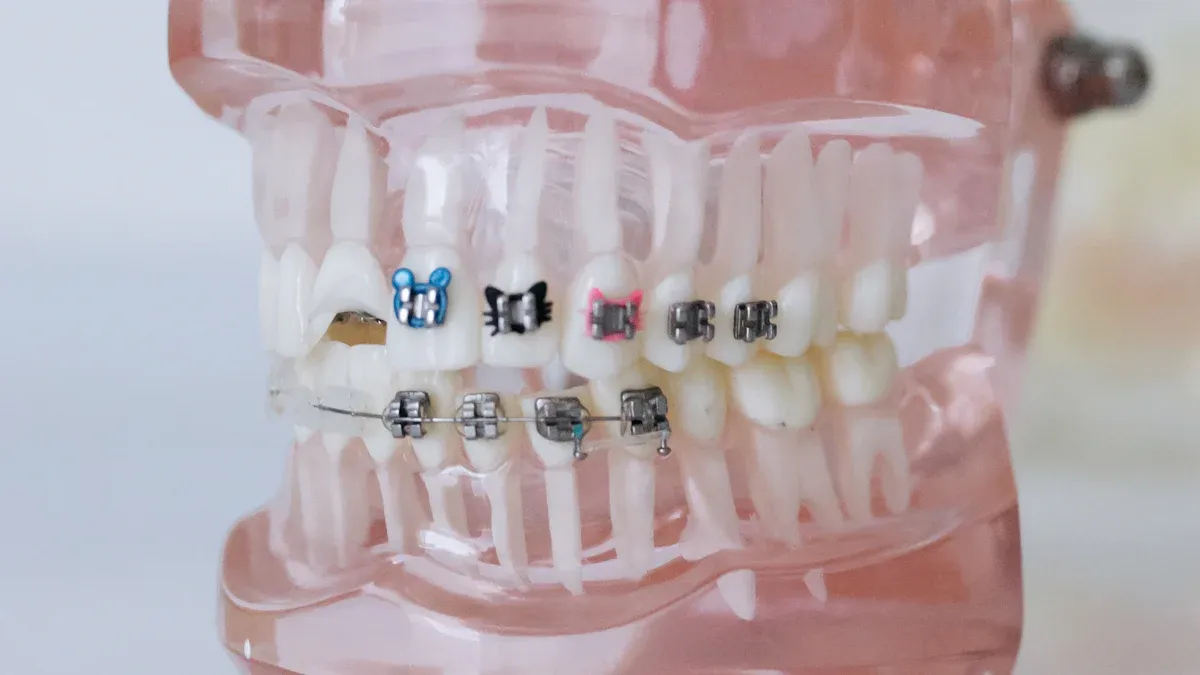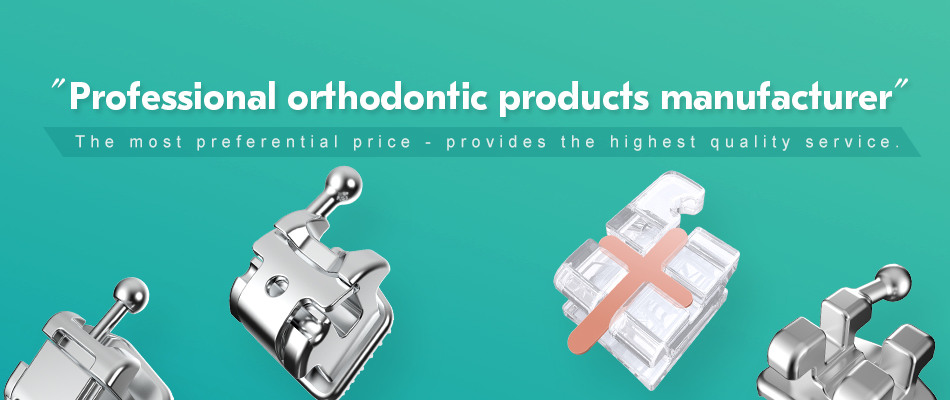The growing demand for customizable braces brackets reflects a shift toward patient-centric orthodontic care. The orthodontics market is projected to expand from $6.78 billion in 2024 to $20.88 billion by 2033, driven by aesthetic dental care needs and digital advancements. Innovations like 3D printing allow manufacturers to address OEM/ODM requirements by enhancing precision and tailoring products to individual specifications, ensuring higher patient satisfaction and operational efficiency.
Key Takeaways
- Custom braces brackets help patients by fitting their teeth better. This leads to faster treatment and fewer changes needed.
- New tech like 3D printing and CAD tools make braces more accurate and comfy. This makes them popular with dentists and patients.
- OEM/ODM models save money for braces brands. They can focus on ads while still offering great, custom products.
The Importance of Customizable Braces Brackets in Orthodontics

Meeting Patient-Specific Needs
Customizable braces brackets address the unique dental structure of each patient, offering a tailored approach to orthodontic care. Unlike traditional systems, these brackets are designed using advanced technologies like 3D imaging and CAD software, ensuring a precise fit for every tooth. This precision minimizes the need for frequent adjustments, reducing the overall treatment duration.
- Studies confirm that customized brackets enhance precision in tooth movement, leading to shorter treatment times.
- A comparison between Insignia (customized) and Damon (non-customized) brackets revealed superior clinical efficiency in the Insignia group.
By meeting patient-specific needs, these brackets improve both the effectiveness and efficiency of orthodontic treatments.
Enhancing Treatment Accuracy and Comfort
Advancements in orthodontic technology have significantly improved the accuracy and comfort of braces. Digital scanning replaces traditional molds, providing precise impressions that enhance treatment outcomes. Self-ligating brackets, a feature of many customizable systems, reduce friction during tooth movement, resulting in smoother adjustments and less discomfort.
- Modern materials, such as 3D-printed ceramic polycrystalline alumina, offer durability and comfort.
- Designs now focus on minimizing irritation, ensuring a better experience for patients.
These innovations make customizable braces brackets a preferred choice for both orthodontists and patients seeking optimal results.
The Shift Toward Personalized Orthodontic Care
The orthodontics industry is moving toward personalized care, driven by technological advancements. Customizable braces brackets exemplify this trend, offering solutions tailored to individual dental needs. Technologies like 3D printing and CAD enable orthodontists to create brackets that align perfectly with each patient’s teeth.
| Metric | Customized Brackets | Traditional Systems | Difference |
|---|---|---|---|
| Mean Treatment Duration | 14.2 months | 18.6 months | -4.4 months |
| Adjustment Visits | 8 visits | 12 visits | -4 visits |
| ABO Grading System Score | 90.5 | 78.2 | +12.3 |
This shift toward personalization not only enhances treatment outcomes but also aligns with the growing demand for patient-centric solutions in orthodontics.
OEM/ODM Manufacturing and Its Role in Orthodontics
Understanding OEM/ODM in Orthodontic Products
OEM (Original Equipment Manufacturer) and ODM (Original Design Manufacturer) models have become integral to the orthodontic industry. These manufacturing approaches allow companies to produce high-quality orthodontic products, including customizable braces brackets, without investing heavily in infrastructure or design. By leveraging OEM/ODM services, brands can focus on marketing and distribution while relying on specialized manufacturers for production.
The global EMS and ODM market is projected to grow from USD 809.64 billion in 2023 to USD 1501.06 billion by 2032. This growth highlights the increasing reliance on these models across industries, including orthodontics. In Europe, the orthodontic market is expected to grow at an annual rate of 8.50%, reaching USD 4.47 billion by 2028, driven by the cost-effectiveness and scalability of OEM/ODM solutions.
Cost-Effectiveness and Scalability for Manufacturers
OEM/ODM manufacturing offers significant cost advantages. These models reduce production expenses by utilizing economies of scale and advanced manufacturing technologies. For orthodontic brands, this translates into affordable yet high-quality products.
For instance, white-label solutions enable brands to save on production costs while maintaining product quality. Companies like K Line Europe have captured over 70% of the European white-label clear aligner market by leveraging these cost-effective strategies. Additionally, the scalability of OEM/ODM models ensures that manufacturers can meet growing demand without compromising efficiency.
Branding Opportunities with Customizable Solutions
Customizable orthodontic products provide brands with unique opportunities to enhance their market presence. White-label solutions allow companies to market high-quality products under their own brand name, fostering trust and recognition among consumers.
Case studies reveal the success of branding through customizable solutions. For example, a company launching aligners in France, Germany, and the US achieved a 600% volume increase in the first year. Structured onboarding processes, clinical support, and educational content contributed to this success. By offering customizable braces brackets, brands can differentiate themselves in a competitive market while meeting patient-specific needs.
Technologies Enabling Customizable Braces Brackets

CAD Software for Precision Design
Computer-Aided Design (CAD) software has revolutionized the orthodontics industry by enabling precise customization of braces brackets. This technology allows orthodontists to design brackets tailored to individual dental structures, ensuring optimal fit and functionality. For instance, Ubrackets software imports dental arch scans, enabling orthodontists to customize brackets fully or partially. The software aligns brackets on a flat archwire, ensuring accurate positioning without tooth contact.
| Feature | Description |
|---|---|
| Predictable Outcomes | Highly predictable bracket positioning outcomes. |
| Precise Data Expression | Accurate expression of bracket data based on personalized typodonts. |
| Reduced Risks | Fewer orthodontic risks due to enhanced precision. |
| 3D Printing | Digital IDB trays fabricated through 3D printing for virtual bracket positions. |
| Improved Comfort | Reduced chairside time enhances patient comfort. |
This precision minimizes risks and improves treatment outcomes, making CAD software indispensable for designing customizable braces brackets.
3D Printing for Efficient Production
3D printing has emerged as a game-changer in the production of orthodontic brackets. It enables manufacturers to produce highly accurate and patient-specific brackets efficiently. The technology reduces the need for adjustments during appointments, saving time for both orthodontists and patients.
| Metric | Description |
|---|---|
| Efficiency | Shortens treatment duration by reducing adjustments. |
| Reduced Chair Time | Accurate fit minimizes modifications during appointments. |
| Customization Benefits | Patient-specific brackets ensure predictable results. |
By streamlining production and enhancing customization, 3D printing supports the growing demand for patient-centric orthodontic solutions.
Advanced Materials for Durability and Quality
The use of advanced materials has significantly improved the durability and quality of orthodontic brackets. Research on zirconia brackets with varying yttria proportions demonstrates enhanced reliability in dimensional accuracy and optical stability. The 3Y-YSZ variant, for example, shows exceptional potential due to its frictional resistance and fracture strength.
Additionally, collaborations between software developers and hardware manufacturers have led to innovative designs tailored to individual dental structures. Companies like 3M are advancing iron-based materials for custom-fit brackets, ensuring safety and compliance through streamlined FDA approval processes. These advancements not only enhance the mechanical properties of brackets but also improve patient comfort and treatment efficiency.
Market Trends and Future Outlook for 2025
Rising Demand for Patient-Centric Orthodontic Solutions
The orthodontics market is experiencing a significant shift toward patient-centric solutions. This trend reflects the growing demand for treatments tailored to individual needs. Customizable braces brackets play a pivotal role in this transformation, offering precision and comfort that align with patient expectations.
Market analyses highlight this growth trajectory. For instance:
| Market Size in 2025 | Forecast Period | CAGR | 2032 Value Projection |
|---|---|---|---|
| USD 6.41 Bn | 2025 to 2032 | 6.94% | USD 10.25 Bn |
This data underscores the increasing preference for personalized orthodontic care, driven by advancements in technology and materials.
Growth of White-Label and Customizable Products
White-label and customizable orthodontic products are gaining traction among manufacturers and brands. These solutions enable companies to reduce production costs while maintaining high-quality standards. Additionally, they allow brands to establish a strong market presence quickly.
Key industry forecasts reveal:
- The orthodontic market in Europe is projected to grow at an annual rate of 8.50%, reaching USD 4.47 billion by 2028.
- The global orthodontics market is expected to grow at a CAGR of 17.2% from 2021 to 2030, with a market size of USD 22.63 billion by 2030.
This growth highlights the scalability and branding opportunities offered by white-label and customizable solutions.
Predictions for Technological Advancements in Orthodontics
Technological innovations are set to redefine orthodontic customization by 2025. CAD/CAM technology, for example, enables precise simulations and virtual treatment planning, enhancing accuracy and efficiency. Similarly, 3D printing facilitates the rapid production of patient-specific orthodontic appliances.
Emerging technologies include:
- AI-powered treatment planning for enhanced personalization.
- Digital scanning to replace traditional impressions, improving comfort and precision.
- Virtual reality applications for better visualization and customization.
These advancements promise to elevate the orthodontics industry, making treatments more effective and accessible.
Customizable braces brackets have revolutionized orthodontics by addressing patient-specific needs and enhancing treatment outcomes. Technology plays a transformative role by enabling appliance customization, improving predictability, and facilitating in-house production. Collaboration between manufacturers and orthodontic professionals remains essential to drive innovation and meet the growing demand for personalized care.
FAQ
What are customizable orthodontic brackets?
Customizable orthodontic brackets are braces tailored to individual dental structures. They use advanced technologies like CAD and 3D printing to enhance precision, comfort, and treatment outcomes.
How do OEM/ODM models benefit orthodontic manufacturers?
OEM/ODM models reduce production costs and improve scalability. They allow manufacturers to focus on branding and distribution while ensuring high-quality orthodontic products.
Why is 3D printing important in orthodontics?
3D printing enables efficient production of patient-specific brackets. It reduces chair time, enhances customization, and ensures precise fit, improving both patient satisfaction and treatment accuracy.
Post time: Apr-12-2025


